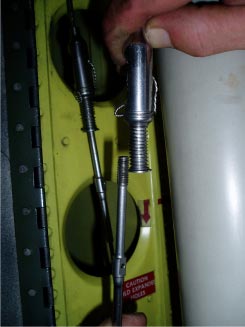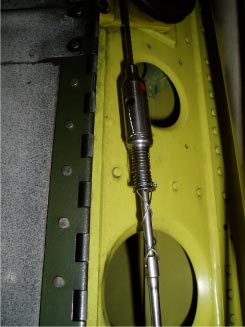Difficulty to Control
Gateway Helicopters Ltd.
Bell 204B C-GRGY
Sudbury, Ontario
The Transportation Safety Board of Canada (TSB) investigated this occurrence for the purpose of advancing transportation safety. It is not the function of the Board to assign fault or determine civil or criminal liability. This report is not created for use in the context of legal, disciplinary or other proceedings. See Ownership and use of content. Masculine pronouns and position titles may be used to signify all genders to comply with the Canadian Transportation Accident Investigation and Safety Board Act (S.C. 1989, c. 3).
Summary
The Bell 204B helicopter (registration C-GRGY, serial number 2022), operated by Gateway Helicopters Ltd., was conducting a survey job at Marathon, Ontario, with a crew comprising a pilot and an aircraft maintenance engineer. They departed Marathon on the day of the occurrence at about 0900 eastern daylight time to return to Sudbury, Ontario, flew to Wawa, Ontario, for fuel, and continued to Sudbury. The helicopter was on final approach to Sudbury Airport at about 1145 with the wind from the south-southwest at less than five knots. When the collective was raised and the cyclic pulled aft to reduce the sink rate and airspeed, the helicopter yawed to the right, and the pilot was unable to correct with left pedal. The collective was lowered and the cyclic pushed forward to increase the airspeed. The helicopter returned to a normal flight condition at 60 KIAS (knots indicated airspeed), and the pedals were neutral. The pilot aborted the approach and flew a left-hand downwind approach for Runway 22.
During the second approach, when the collective was raised to slow the sink rate, there was a thump and the left pedal went to full deflection. The pilot declared an emergency then flew several circuits to determine the best way to make a landing. The helicopter flew well at 40 KIAS, and the heading could be controlled by adjusting the throttle. The helicopter was lined up with the runway about two miles back on a shallow approach and crossed the runway threshold at a height of three to five feet and about 40 KIAS. It touched down gently at approximately 30 KIAS with 80 per cent rotor rpm and skidded about 90 feet before coming to a stop. There were no injuries.
Factual information
At the time of the occurrence, about 1145 eastern daylight time,Footnote 1 the weather was good and not considered to be a factor.
The pilot-in-command (PIC) was seated in the right seat. He held a valid commercial helicopter pilot licence. As of July 2005, the PIC had accumulated approximately 3600 total flying hours and 300 hours on type.
The aircraft maintenance engineer (AME) was properly licensed and had worked in the helicopter industry for two years as an apprentice and three years as a licensed AME. The AME spent his first years working on small helicopters such as the Robinson R22 and R44, and the Bell 206. In the fall of 2002, he moved up to a medium helicopter, the Bell 205. Gateway Helicopters Ltd. hired the AME in March 2004, to work on its Bell 204B, which is similar to the Bell 205.
During the busy season, helicopter companies typically assign a crew consisting of a pilot and an AME to a helicopter. The crew work and fly together wherever the helicopter might be sent or stationed. When the crew is scheduled for time off, another crew is assigned to the helicopter.
On checking the helicopter after the flight, it was discovered that a cable to the tail rotor pitch change mechanism had come undone. Investigation by the company showed that the cable had come undone at one of the two speed rigs,Footnote 2 and that the threaded end of the speed rig had not been lock wired. Additionally, it was found that the threaded end of the other speed rig had also not been lock wired (see Photo 1).
In December 2004, the helicopter was removed from service for repainting and a tailboom change. The AME involved in the occurrence flight removed the pitch control chain and tail rotor assembly, but did not remove the cables or speed rig assemblies that were transferred to the replacement tail boom. He completed the reassembly with the aid of two other engineers and two apprentices. Following the reassembly, the AME rigged and lock wired the tail rotor controls. Because the other two engineers were not experienced on this type of helicopter, the AME had the pilot perform the independent inspection. The aircraft was released into service in February 2005.
The helicopter was flown approximately 270 hours over the next few months. During this time, two 100-hour inspections were completed, which included an Airworthiness Directive (AD) CF90-06 Part A (Part A) inspection. One additional Part A inspection was carried out following a sprocket change on the pitch change mechanism. A Part A inspection calls for removing, inspecting, and reinstalling the chain to the tail rotor pitch change mechanism every 100 hours. Additionally, an AD CF90-06 Part B (Part B) inspection requires a detailed visual inspection of the chain every 25 hours. A Part B inspection was conducted eight times before the occurrence. The chain drives the pitch change mechanism and is attached to the tail rotor pitch change cables by the speed rigs. During the subsequent Part A inspections, the speed rigs were lock wired the same way that they had been found. Six hours before the occurrence, a 50-hour inspection was carried out, which included a Part B inspection. As a precaution, the AME also checked the cable tension. With the exception of one Part A inspection and two Part B inspections, all other Part A and B inspections were performed by the occurrence AME, and the speed rig lock wiring was independently checked by the occurrence pilot.
The investigation found that, following the initial tail-boom installation, the AME followed the procedures in the maintenance manual, but only lock wired the quick disconnect and not the threaded portion of the speed rig. The last part of the instructions states, "Lockwire the speed rigs as shown in figure 7-32. Check complete tail rotor pitch control system for security, safetying and freedom of operation." The maintenance manual instructions were reviewed and found to provide adequate guidance for the task. A properly lock-wired speed rig will have one piece of lock wire securing the quick-disconnect ball end and another piece securing the threaded end (see Photo 2). The error made in lock wiring was duplicated in the subsequent Part A inspections. As well, the investigation found that the hole where the lock wire goes through the speed rig on the threaded end was small and partially hidden by a spring.
The use of control cables in the aviation industry is common practice, especially in older aircraft. While their use is more common in fixed-wing aircraft, where most or all of the flight controls use cables, they are also found in helicopters, although to a much lesser degree. Typically, their use in helicopters has been limited to control input to the tail rotor.
Standard 571.10 of the Canadian Aviation Regulations requires that work that disturbs the engine or flight controls be inspected for correct assembly, locking, and sense of operation by at least two individuals, and that the technical record contain the signatures of both of them. To ensure that these critical systems are assembled correctly before flight, the person performing the independent inspection should be suitably trained and experienced on the type of aircraft. The independent inspection must be completed before the maintenance release.
Although not part of the standard, Airworthiness Notice C010Footnote 3 further explains the requirements and procedures for conducting independent inspections. The pilot had received basic training on independent control checks as part of his elementary maintenance training before the occurrence and met the requirements for completing the inspection. However, he did not detect the missing lock wire on the speed rig while carrying out the independent checks following the tail boom replacement and subsequent Part A inspections.
During the investigation, it was determined that the company employees were knowledgeable in their respective fields and took their work seriously. It was equally evident that everyone took pride in their work and realized the importance of performing their work to the highest standard.
Analysis
Lock wiring a turnbuckle is a relatively basic aircraft maintenance task, but it is a critical task that ensures the safety and security of aircraft control systems. All AMEs learn this task during their formal education and continue to perform it, to varying degrees, throughout their careers. The AME who did the majority of the work was relatively new on the Bell 204. While his past experience included work on similar helicopters and smaller helicopters equipped with cables and turnbuckles, this was the first helicopter the AME had worked on which had this type of quick-disconnect turnbuckle (speed rig). As well, the hole where the lock wire goes through the threaded end of the speed rig was difficult to see. The maintenance manual reference to figure 7-32 clearly shows a lock wire in place at both ends of the speed rig. The text reference does not describe how to complete the task, but rather refers to the figure for an example of a properly lock-wired speed rig. Despite the AME's professional approach to maintenance tasks and flight safety, the basic task of lock wiring the turnbuckle was improperly performed.
The AME chose to have the pilot conduct the independent inspection because the pilot was familiar with the machine, qualified by the company to perform this task, and available. In spite of his qualification, when the pilot looked at the speed rigs on several occasions and saw lock wire, he assumed that the speed rig was correctly lock wired, when in fact it was not. The pilot had received elementary maintenance training on the aircraft, which included independent control system inspections. However, this instruction was not in depth and did not include detailed instructions on what to check or how to check the system. The potential for similar occurrences exists within any organization that uses personnel who are not fully trained and experienced on the type of system operation and installation being inspected.
Findings
Findings as to causes and contributing factors
- The tail rotor pitch change cable speed rigs were not lock wired in accordance with approved methods. As a result, one cable speed rig came undone, and tail rotor authority was lost.
- The independent control inspection was not carried out in accordance with the standards described in the Canadian Aviation Regulations or relevant Airworthiness Notification, and the missing lock wire was not detected.
Findings as to risk
- The pilot conducting the independent inspection was qualified and had received elementary maintenance training that included independent control checks. However, without specific training on maintenance procedures and standards, there is an increased risk of missing maintenance-related deficiencies.
Safety action
Safety action taken
Following the occurrence, the operator conducted a training program for maintenance and operations personnel. The aim of the program was to refresh all personnel in the proper locking of turnbuckles and aircraft components in general, and to educate all personnel on what to look for when conducting an independent inspection on each aircraft operated by the company. The aircraft maintenance engineer (AME) who was involved in this occurrence developed and delivered the program to employees.
The Board is concerned that companies using pilots to conduct independent inspections may not have developed training programs of sufficient detail to prevent similar occurrences.
This report concludes the Transportation Safety Board's investigation into this occurrence. Consequently, the Board authorized the release of this report on .

